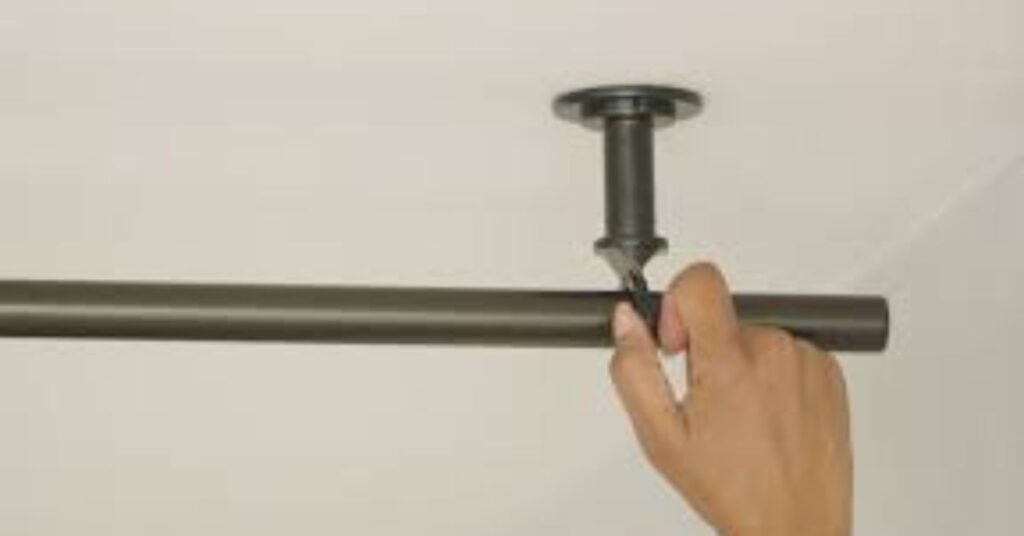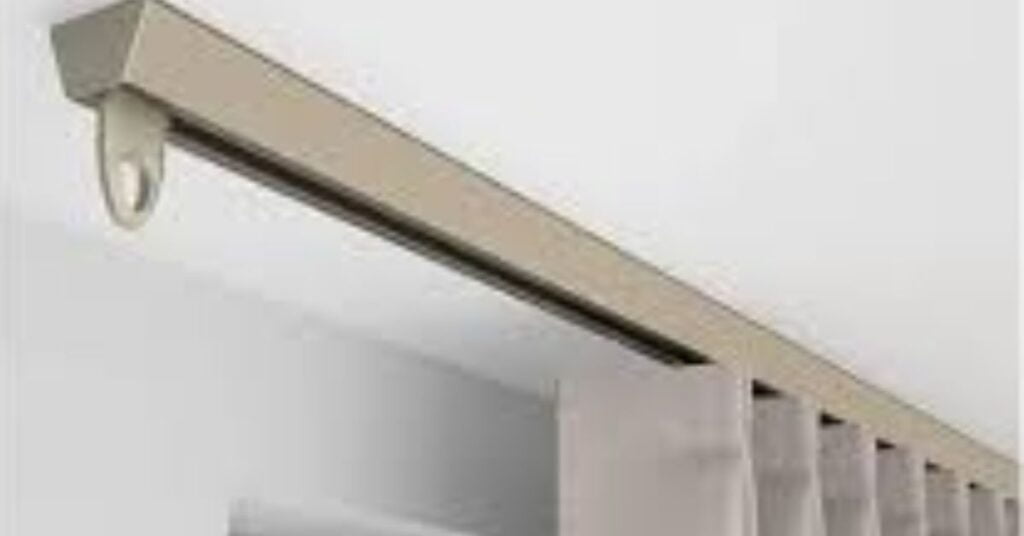if you are looking to add a touch of elegance, create room dividers, or simply enhance your privacy, hanging curtains from the ceiling can transform any space.
Traditional methods often involve drilling into walls or using curtain rods, which may not be feasible for everyone due to various reasons like rental agreements or concerns about damaging the walls.
Fortunately, there are alternative methods available that allow you to hang curtains from the ceiling without drilling. In this blog post, we’ll examine various methods and give you a step-by-step guide on how to hang curtains from the ceiling.
Benefits of Hanging Curtains from the Ceiling without Drilling
- Versatility: The placement of curtains and the design of the room are more flexible when they are hung from the ceiling. You can use innovative space-dividing techniques to produce one-of-a-kind visual effects.
- No Wall Damage: By avoiding drilling holes in the walls, you can preserve the integrity of your walls and prevent potential damage, which makes it the perfect solution for rented spaces or temporary setups.
- Enhance Height perception: Height perception is increased when curtains are hung from the ceiling, giving the impression that the room is larger and more open.
- Privacy and Light Control: Ceiling-mounted curtains are an effective way to add privacy, block out light, and manage the amount of natural light that enters a space.
- Aesthetic Appeal: Ceiling-mounted curtains can add a touch of style and elegance to any space, enhancing the interior design and producing a dramatic effect.
Precautions and Factors to Consider
- Limitations on weight: Before hanging curtains from the ceiling, make sure the ceiling structure can support the weight of the drapes, curtain rods, and any additional hardware. For weight restrictions, seek professional advice or consult the manufacturer’s instructions.
- Safety first: To avoid mishaps or damage, make sure the curtain installation is solid and stable. Take precautions to prevent any potential risks, such as curtains that could tangle, fall, or injure people.
- Length and material: Take into account the length and weight of the curtains you plan to hang. To maintain stability, heavier or longer curtains may need more robust mounting techniques.
- Ceiling Height: Consider where you want the curtains to be placed as well as the height of your ceiling. Make sure that any light fixtures or ceiling fans won’t be harmed by the curtains.
- Maintenance: Cleaning and upkeep procedures may differ depending on the curtain material and hanging technique. Take accessibility and cleaning convenience into account.
You can proceed with confidence and hang curtains from the ceiling without drilling by taking into account these advantages and safety measures. This will give your living space more functionality and style.
Tools and Materials Needed
Curtain Rod or Track System
- Curtain Rod: Opt for a lightweight curtain rod that can be mounted on the ceiling. Choose a sturdy, movable rod that matches the width of the curtains you want to hang where you want them.
- Curtain Rings or Clips: To attach the curtains to the rod, you may need curtain rings or clips, depending on the style of the curtain rod.
Ceiling Mounting Hardware Alternatives
- Adhesive Hooks: Look for sturdy adhesive hooks made especially for mounting on ceilings. Make sure their weight capacity is appropriate for your curtains.
- Magnetic Hooks: Magnetic hooks can be a practical choice for metal ceilings. Select hooks whose weight capacity corresponds to the weight of your curtain.
- Tension Wire Systems: Tension wire systems employ movable wires with ceiling-attachable hooks. These are perfect for sheer curtains.
- Suspended Wire Systems: In suspended wire systems, cables or wires are mounted from the ceiling, and curtains are fastened with hooks or clips. For heavier curtains, this option offers flexibility and stability.
Curtains and Hooks
- Choose curtains for your window or space that match your decor and are the right length and width. Ensure the fabric’s weight is appropriate for your chosen hanging method.
- Hooks or clips: Depending on your curtain rod or mounting system, hooks or clips may be required to fasten the curtains firmly. Select hooks or clasps that work with your curtain rod or your preferred hanging technique.
Make sure you have all the equipment and supplies needed before beginning the curtain installation procedure. This will facilitate a successful hanging and make the process run more smoothly.
Preparation
Measure and Mark the Placement
- Measure the Window or Area: Take a measurement of the window’s width and height, or the space where you want to hang the curtains. Think about how far you want the curtains to hang past the window.
- Place your marker here: Mark the desired location for the curtains on the ceiling with a pencil or piece of tape. Verify that the markings are level and in line with the window or other desired location.
Locate Ceiling Joists or Studs
- Use a Stud Finder: Use a stud finder to identify the joists or studs in the ceiling above the space where you intend to hang the curtains. For proper support and stability, this step is crucial.
- Mark the locations of the ceiling joists or studs with a pencil or some masking tape. When deciding on the best hanging technique, use this as a guide.
Determine Weight Capacity
- Consult the manufacturer’s instructions: Verify the weight capacity requirements listed by the manufacturer for the chosen mounting hardware or curtain rod.
- Think about the weight of the curtains: Calculate the total weight of your curtains, including any additional rings or clips. Make sure the weight doesn’t exceed what the chosen hanging method can handle.
- Consider the Safety Margin: To ensure maximum stability and safety, it is advised to stay well below the weight capacity.
You can proceed with the hanging process and select the proper hardware for your ceiling-mounted curtains by taking precise measurements, locating the ceiling joists or studs, and figuring out the weight capacity.
Hanging Methods
Method 1: Tension Rod Installation

- Choose a Tension Rod:
- Opt for a tension rod that is appropriate for the width and weight of the curtain you want to hang. Make sure it is intended for mounting on the ceiling.
- Measure and Adjust the Rod:
- The distance between the marked points on the ceiling should be measured.
By twisting the rod until it fits snugly, you can adjust the width to your liking.
- The distance between the marked points on the ceiling should be measured.
- Insert the Tension Rod:
- Place the rod horizontally between the marked points on the ceiling while holding it in both hands.
- The rod should be extended until both ends are firmly pressed against the ceiling. The rod ought to be secured by the tension.
- Hang Curtains:
- Onto the tension rod, slide the curtain rings or clips.
- Curtains should be fastened to the rings or clips.
- For the desired appearance and coverage, adjust the curtains as necessary.
Method 2: Ceiling Mounting Hardware Alternatives

- Adhesive Hooks:
- Clean the area of the ceiling where the hooks will be positioned.
- At the marked locations, remove the hooks’ adhesive backing and firmly press them into the ceiling.
- Apply the manufacturer’s instructions and wait for the adhesive to dry.
- Use the clips or hooks that are fastened to the adhesive hooks to hang the curtains
- Magnetic Hooks:
- Attach the magnetic hooks to the ceiling at the indicated locations with tape.
- Make sure they are firmly affixed to the metal ceiling surface.
- Utilize the clips or hooks that are fastened to the magnetic hooks to hang the curtains.
- Tension Wire Systems:
- Set up the tension wire system in accordance with the directions provided by the manufacturer.
- At the indicated locations, fasten the system’s provided hooks to the ceiling.
- To achieve the desired height and tightness, adjust the wire tension.
- Utilize the hooks or clips fastened to the tension wires to hang the curtains.
- Suspended Wire Systems:
- Mount the wires or cables from the ceiling at the designated points to complete the installation of the suspended wire system.
- the wires with hooks or clips.
- Utilizing the hooks or clips fastened to the hanging wires, hang the curtains.
Method 3: Curtain Track System

- Select the Curtain Track:
- Opt for a curtain track system that can be mounted on the ceiling. Think about the size and weight of your curtains.
- Measure and Cut the Track:
- The distance between the marked points on the ceiling should be measured.
- A saw or other suitable cutting tool should be used to cut the curtain track to the desired width.
- Install the Track:
- Mounting the track to the ceiling requires adhering to the manufacturer’s instructions.
- Make sure the track is level and firmly fastened.
- Hang Curtains:
- The curtain track should be equipped with curtain hooks or clips.
- Curtains should be hung from the hooks or clips.
- The curtains can be moved as needed along the track.
You won’t need to drill holes in the ceiling to install your ceiling-mounted curtains if you follow these detailed instructions for each hanging method.
Finishing Touches
Adjusting the Curtains
- After the curtains are hung, make any necessary adjustments to make sure they are distributed equally and have the desired appearance.
- Make sure the curtains are straight and evenly spaced.
- To achieve the desired look, adjust the curtains’ height, width, or gathering as necessary.
Securing Loose Ends
- Verify for any hanging extra fabric or loose ends.
- To tidy up the look and secure any loose ends, use curtain ties or clips.
- To prevent the curtains from unraveling or tangling, make sure they are firmly fastened.
Testing Stability and Functionality
- To check for stability and make sure the curtains are mounted securely, give them a gentle tug.
- Look for any indications of instability, swaying, or sagging.
- To ensure smooth operation and that they are not blocking any objects or furniture, open and close the curtains as needed.
It’s crucial to pay attention to these finishing touches if you want your ceiling-mounted curtains to have a polished and expert appearance.
You can make sure that your curtains are not only aesthetically pleasing but also useful and functional by adjusting them, tying up any loose ends, and testing their stability and functionality.
Maintenance and Removal
Cleaning and Care Tips
- To get rid of any accumulated dirt or dust, dust or hoover the curtains frequently.
- Depending upon the type of fabric used in the curtains, follow the manufacturer’s cleaning instructions.
- Any spills or stains should be cleaned up right away to avoid them setting.
- Depending on the fabric and usage, think about periodically removing the curtains for a thorough cleaning.
Removing and Repairing Ceiling Mounts
- Gently twist and retract tension rods from the ceiling to remove them.
- Follow the manufacturer’s instructions when removing adhesive hooks from the ceiling surface.
- Pulling magnetic hooks down or to the side makes them simple to remove.
- Remove the hooks or clips from the wires in tension wire systems or suspended wire systems before removing the wires from the ceiling mounts.
- Following the manufacturer’s instructions, curtain track systems can be uninstalled by removing the screws or clips holding them in place.
- Consult the manufacturer’s instructions for repair or replacement options if any ceiling mounts or hardware is damaged during removal.
Note: Take care not to damage the ceiling surface when removing ceiling mounts or hardware. If necessary, repair any holes or stains left behind using the proper techniques or supplies.
You can extend the life of your curtains and preserve the quality of your ceiling by following proper cleaning and maintenance procedures and exercising caution when removing them.
Conclusion
- Installation of Tension Rods: Without drilling, hang curtains quickly and adaptably using tension rods.
- Alternatives to Ceiling Mounting Hardware: For alternative methods of ceiling mounting, consider options like adhesive hooks, magnetic hooks, tension wire systems, or suspended wire systems.
- Curtain Track System: Install a curtain track system made for ceiling mounting for a more dependable and elegant curtain hanging option.
Enjoying Your Ceiling-Mounted Curtains
- When your curtains are properly installed, stand back and savor the improved aesthetic appeal and practicality they give your room.
- Spend some time styling and adjusting your curtains to get the look and coverage you want.
- Benefit from the privacy, light control, aesthetic appeal, and sense of space that ceiling-mounted curtains can offer.
- To ensure the longevity and continued enjoyment of your curtains, maintain and care for them in accordance with the specific cleaning and maintenance instructions.
You can successfully hang curtains from the ceiling without drilling by following the provided instructions and taking into account the advantages, safety measures, tools, and hanging techniques. Ceiling-mounted curtains offer versatility and style, so embrace them and enjoy the transformation they bring to your living space
FAQs
How do I use ceiling-mounted curtain tracks to hang curtains without drilling?
Measure the width of your window and select a track system that suits your needs. Install the tracks on the ceiling using screws or adhesive, following the manufacturer’s instructions. Attach the hooks or gliders to the curtains and hang them on the track, allowing them to slide smoothly.
What are tension rods, and how do I use them to hang curtains from the ceiling?
To hang curtains from the ceiling using tension rods, measure the width of your window and select a rod that fits snugly. Position the rod close to the ceiling and adjust it until it’s secure. Then, hang your curtains from the rod using curtain rings or clips.
Will hanging curtains from the ceiling without drilling damage the walls or ceiling?
When using tension rods, ceiling-mounted tracks, or adhesive hooks, the risk of wall or ceiling damage is minimal.
Also Read:
Explore Best Ceiling Mounted Curtains Ideas
Shoe Molding On Stairs: A Step-By-Step Guide To Perfect Installation
